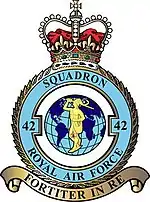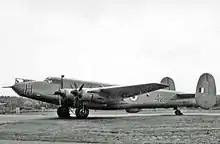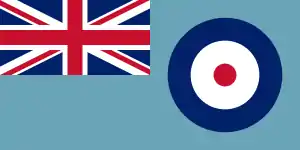No. 42 Squadron RAF
Number 42 Squadron was a squadron of the Royal Air Force. It served during the First World War as an army co-operation squadron and during the Second World War in various roles. Between 1992 and 2010, it was the Operational Conversion Unit (OCU) for the Hawker Siddeley Nimrod MR.2, based at RAF Kinloss, Moray, until the Nimrod MR.2's retirement in March 2010. No. 42 Squadron disbanded on 26 May 2011.
| No. 42 Squadron RAF | |
|---|---|
 | |
| Active | 1 April 1916 – 1 April 1918 (RFC) 1 April 1918 – 26 June 1919 (RAF) 14 December 1936 – 30 June 1945 1 July 1945 – 30 December 1945 1 October 1946 – 15 October 1947 28 June 1952 – 26 May 2011 |
| Country | |
| Branch | |
| Motto(s) | Latin: Fortiter in re (Translation: "Bravely into action")[1][2] |
| Battle honours | Western Front, 1916–1918*: Italian Front & Adriatic, 1917–1918*: Somme, 1916 Arras, 1917: Ypres, 1917: Lys: Channel & North Sea, 1939–1942*: Biscay, 1940*: Baltic, 1941*: Fortress Europe, 1941: Pacific, 1943–1945: Eastern Waters, 1943*: Arakan, 1943–1944*: Manipur, 1944*: Burma, 1944–1945: South Atlantic, 1982: Gulf, 1991. Honours marked with an asterisk (*) are those emblazoned on the Squadron Standard[3] |
| Insignia | |
| Squadron Badge heraldry | On a terrestrial globe, a figure of Perseus[1][2] No. 42 Squadron was the 1st to use the Bristol Perseus engine and this accounts for the presence of Perseus in the badge; he was known always to achieve his object and destroy his enemies and he stands in front of a globe to signify his activities over many lands and seas[1] |
| Squadron Codes | QD (Allocated Apr 1939 – Sep 1939, but probably not used)[4][5] AW (Sep 1939 – Jun 1942 1943 – Dec 1945)[6][7] QM (Oct 1946 – Oct 1947)[8][9] A (Jun 1952 – 1956)[10][11] 42 (1956–1968) |
History
First World War
Formed on 1 April 1916 from crews of No. 19 Squadron Royal Flying Corps at RAF Filton, No. 42 Squadron spent the First World War flying reconnaissance sorties. Using Royal Aircraft Factory BE.2s (and later Royal Aircraft Factory R.E.8s), the squadron spent time on both the Western Front and the Austro-Italian Front. On returning to England after the war, the squadron was disbanded at RAF Netheravon on 26 June 1919.[1][12]
Second World War
On 14 December 1936, 'B' flight of No. 22 Squadron was expanded into a new No. 42 Squadron.[1][2] In 1939, No. 42 Squadron was based at RAF Bircham Newton. Initially the unit was equipped with Vickers Vildebeests before re-equipping with Bristol Beauforts in January 1940. The squadron operated also a bomber unit in the Burma campaign flying Blenheims during 1942 and as a fighter-bomber unit flying Hawker Hurricanes during 1943. The squadron disbanded on 30 June 1945 but on the following day No. 146 Squadron was renumbered to No. 42 Squadron and flew Republic Thunderbolts Mk.IIs.[2] The squadron fought on with these until the Burma campaign ended and thereafter the squadron disbanded on 30 December 1945 at Meiktela.[1][12]
Beaufighters and Shackletons (1946–1971)

On 1 October 1946, No. 254 Squadron at RAF Thorney Island was renumbered to No. 42 Squadron. Equipped with Bristol Beaufighter, it was a strike unit in RAF Coastal Command until disbanded on 15 October 1947.[2][12]
On 28 June 1952, No. 42 Squadron was reformed at RAF St. Eval, Cornwall, flying Avro Shackleton MR.1s in the maritime reconnaissance role.[12] In 1954, the squadron began to re-equip with the Shackleton MR.2.[3] On 11 January 1955, two squadron Shackleton MR.2s (WG531 and WL743) disappeared while operating near Fastnet Rock.[13] No. 42 Squadron Shackletons used to regularly visit RAF Khormaksar in Aden before the Aden Emergency, with it undertaking colonial policing.[14][15]
No. 42 Squadron relocated to RAF St. Mawgan in October 1958.[3] In 1961, the squadron deployed to Jamaica to provide support for relief operations after Hurricane Hattie struck the Caribbean and British Honduras.[16] It further converted to the Shackleton MR.3 in December 1965.[3] In 1966, No. 42 Squadron deployed to Mahajanga, Malagasy Republic, to take part in the Beira Patrol which enforced the blockade of the port of Beira in Mozambique to prevent oil shipments to Rhodesia.[16]
Nimrods (1971–2011)
%252C_UK_-_Air_Force_AN1835961.jpg.webp)
In April 1971, No. 42 (Torpedo Bomber) Squadron began to convert to the Hawker Siddeley Nimrod MR.1.[2][12] No. 42 (TB) Squadron were the first Nimrod unit to arrive at Wideawake Airfield, Ascension Island, when XV244 and XV258 landed on 6 April 1982 shortly after the invasion of the Falkland Islands.[17] In October 1984, one of No. 42 (TB) Squadron's crews won the Fincastle Trophy at RAAF Base Edinburgh, South Australia.[17] On 29 August 1985, Nimrod MR.2 XV229 helped locate the wreck of Virgin Atlantic Challenger.[17]
The squadron served in Gulf 1 Operation Granby where one of its crew was credited with having achieved the highest number of "Assisted Kills", achieved operating in a High Air Threat environment. The same crew subsequently received the Arthur Barratt Memorial Award. Disbanded as a front-line unit in October 1992, it was later reformed as No. 42 (Reserve) Squadron at RAF Kinloss, Moray, taking over from No. 236 OCU as the Nimrod Operational Conversion Unit (OCU).[18] The squadron flew its last Nimrod MR.2 flight on 30 March 2010,[19] and was formally disbanded on 26 May 2011.[20]
Aircraft operated
| From | To | Aircraft | Version |
|---|---|---|---|
| April 1916 | August 1916 | B.E.2 | 2d |
| April 1916 | April 1917 | B.E.2 | 2e |
| April 1917 | February 1919 | R.E.8 | |
| December 1936 | December 1937 | Vickers Vildebeest | Mk.III |
| January 1937 | March 1937 | Vickers Vildebeest | Mk.I |
| March 1937 | April 1940 | Vickers Vildebeest | Mk.IV |
| September 1939 | April 1940 | Vickers Vildebeest | Mk.III |
| April 1940 | January 1942 | Bristol Beaufort | Mk.I |
| January 1942 | February 1943 | Bristol Beaufort | Mk.II |
| February 1943 | October 1943 | Bristol Blenheim | Mk.V |
| October 1943 | June 1945 | Hawker Hurricane | Mk.IV |
| September 1944 | December 1944 | Hawker Hurricane | Mk.IIc |
| April 1945 | June 1945 | Hawker Hurricane | Mk.IIc |
| July 1945 | December 1945 | Republic Thunderbolt | Mk.II |
| October 1946 | October 1947 | Bristol Beaufighter | TF.10 |
| June 1952 | July 1954 | Avro Shackleton | MR.1/1A |
| January 1953 | January 1966 | Avro Shackleton | MR.2 |
| November 1965 | September 1971 | Avro Shackleton | MR.3 |
| April 1971 | August 1984 | Hawker Siddeley Nimrod | MR.1 |
| August 1983 | April 2011 | Hawker Siddeley Nimrod | MR.2 |
References
Notes
- Rawlings 1982, p. 65.
- Halley 1988, p. 95.
- Barrass, M. B. (2015). "No. 42 Squadron". Air of Authority - A History of RAF Organisation. Retrieved 9 October 2015.
- Bowyer & Rawlings 1979, p. 12.
- Flintham & Thomas 2003, p. 51.
- Bowyer & Rawlings 1979, p. 18.
- Flintham & Thomas 2003, p. 63.
- Bowyer & Rawlings 1979, p. 86.
- Flintham & Thomas 2003, p. 155.
- Bowyer & Rawlings 1979, p. 126.
- Flintham & Thomas 2003, p. 192.
- Jefford 2001, p. 42.
- "Accident Avro Shackleton MR.2 WL743, 11 Jan 1955". Aviation Safety Network. Retrieved 7 February 2021.
- "Visiting military aircraft". radfanhunters.co.uk. Retrieved 7 February 2021.
- "RAF 42 SQUADRON IN ADEN (REEL 1) [ALLOCATED TITLE]". Imperial War Museum. Retrieved 7 February 2021.
- Hill, David. "BALLYKELLY - THE SHACKLETON ERA 1952-1971". The Shackleton Association. Retrieved 7 February 2021.
- "Target Lock: BAE Systems Nimrod". Target Lock. 4 March 2013. Archived from the original on 13 March 2016. Retrieved 7 February 2021.
- "42 Squadron". www.raf.mod.uk. Royal Air Force. Archived from the original on 10 December 2009. Retrieved 4 May 2010.
- Hastings, David. "BAE System Nimrod: Squadron Service". Target Lock. Archived from the original on 8 July 2010. Retrieved 4 May 2010.
- "Squadron Disbandment Parade". www.raf.mod.uk. Royal Air Force. 27 May 2011. Retrieved 29 May 2011.
- Coleman 1992, p. 110.
Bibliography
- Bowyer, Michael J.F.; Rawlings, John D.R. (1979). Squadron Codes, 1937–56. Cambridge, UK: Patrick Stephens Ltd. ISBN 0-85059-364-6.
- Coleman, Ian (1992). Resolute in Action: The History of 42 Squadron RAF, 1916–1992. St Mawgan, Cornwall, UK: Blackfords of Cornwall.
- Flintham, Vic; Thomas, Andrew (2003). Combat Codes: A Full Explanation and Listing of British, Commonwealth and Allied Air Force Unit Codes since 1938. Shrewsbury, Shropshire, UK: Airlife Publishing Ltd. ISBN 1-84037-281-8.
- Halley, James J. (1988). The Squadrons of the Royal Air Force & Commonwealth, 1918–1988. Tonbridge, Kent, UK: Air-Britain (Historians) Ltd. ISBN 0-85130-164-9.
- Jefford, Wing Commander C.G. (2001). RAF Squadrons, a Comprehensive record of the Movement and Equipment of all RAF Squadrons and their Antecedents since 1912 (2nd ed.). Shrewsbury, Shropshire, UK: Airlife Publishing Ltd. ISBN 1-85310-053-6.
- Rawlings, John D.R. (1982). Coastal, Support and Special Squadrons of the RAF and their Aircraft. London: Jane's Publishing Company Ltd. ISBN 0-7106-0187-5.
External links
| Wikimedia Commons has media related to No. 42 Squadron RAF. |
